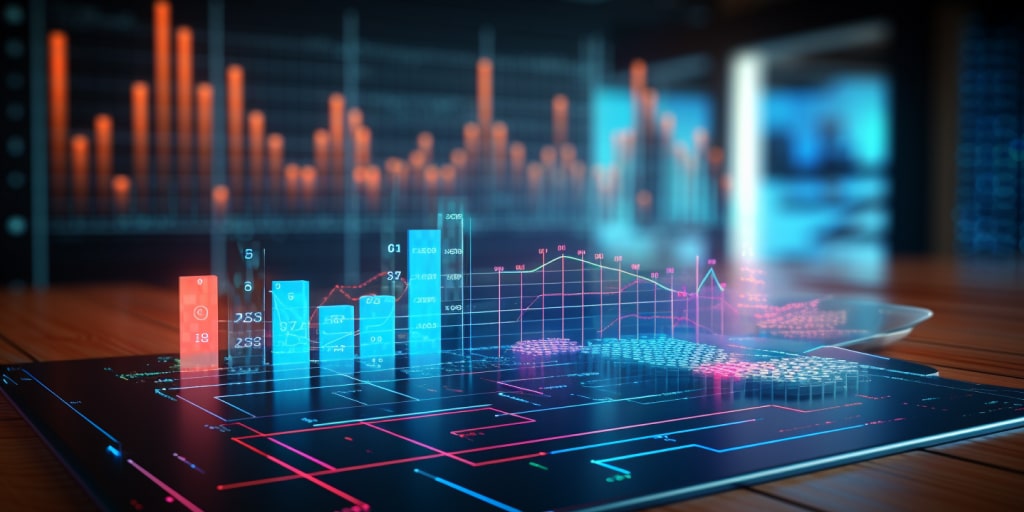
AI-based technologies have penetrated almost every aspect of our life, and that includes (in no small part) data analytics. In fact, if you think of it, AI and data analysis seem to have always been destined to be together.
After all, who (or is it a “what”?) can work with numbers better than… numbers? Much like the titular character from the Terminator franchise, AI-powered tools are armed with emotionless, unbiased logic and will absolutely not stop until they come to a rational conclusion. This makes them ideal for businesses that need exactly that type of approach.
Here in this article, we explore the synergy between AI and data analytics, examine how businesses are leveraging AI-driven insights for better decision-making, and how this integration provides a competitive advantage. Let’s kick it!

AI plays a crucial role in modern data analytics, revolutionizing the way organizations extract marketing insights from their data. AI-based techniques are used to:
Let's explore some of the key AI techniques used in data analytics.
Machine learning algorithms enable computers to learn from data and improve their performance without being explicitly programmed to do so. Supervised learning algorithms, such as decision trees and neural networks, are used to classify data or make predictions based on labeled examples.
Unsupervised learning algorithms, like clustering and dimensionality reduction, help identify patterns and relationships in data without predefined labels.
NLP focuses on enabling computers to understand and interpret human language. It involves techniques like text mining, sentiment analysis, and language generation.
NLP algorithms are used to extract insights from unstructured text data, such as customer reviews, social media posts, and emails, helping organizations understand customer sentiment, automate customer support, and improve data-driven decision-making.
Predictive modeling uses historical data to build models that can predict future outcomes or behaviors. Techniques like regression analysis, time series analysis, and ensemble methods are used to create predictive models.
These models can be used for various purposes, such as forecasting sales, predicting customer churn, optimizing inventory levels, and detecting fraud.
Deep learning is a subset of machine learning that focuses on training artificial neural networks with multiple layers to learn complex patterns and representations.
Deep learning techniques, such as convolutional neural networks (CNNs) and recurrent neural networks (RNNs), have achieved remarkable success in image recognition, speech recognition, natural language processing, and other domains.
These AI techniques, along with advancements in big data analytics and cloud computing, have significantly enhanced the capabilities of data analytics and financial analytics. They enable businesses to uncover hidden insights, automate repetitive tasks, improve decision-making, and gain a competitive edge in today's data-driven world.
The impact that AI-driven analytics has on the decision-making process is hard to underestimate. Naturally, online businesses are more eager to embrace and utilize AI-based methods – however, even brick-and-mortar businesses can benefit from AI, mostly by using it to analyze their marketing and customer data.
Here are some real-life examples of major brands using industry-specific AI applications and AI-driven data analytics to their advantage.
The popular streaming platform relies heavily on AI-based analytics to personalize user experiences and optimize content recommendations.
Netflix analyzes user behavior, viewing patterns, and preferences, which helps to suggest personalized content recommendations to the subscribers. This data-driven approach has significantly improved customer satisfaction and retention rates, as users are more likely to engage with content that aligns with their interests.
Amazon uses AI analytics to enhance its supply chain management and improve customer experiences. By analyzing customer preferences, purchasing patterns, and inventory levels, the company's AI algorithms can predict demand, optimize inventory management, and ensure timely deliveries.
This helps Amazon to increase its operational efficiency, enable cost reduction, and provide a seamless shopping experience for its customers.
Uber relies on AI-driven data analytics to optimize its pricing strategies and improve driver allocation. To do so, they first have to analyze real-time data, including traffic patterns, demand fluctuations, and driver availability. Once all the numbers are in place, Uber's AI algorithms can use them to dynamically adjust prices and allocate drivers to high-demand areas.
Through analyzing consumer data, social media and market trends, Coca-Cola's AI algorithms can identify target audiences, personalize marketing messages, and predict consumer preferences. This data-driven decision-making allows the famous brand to create more effective marketing campaigns, increase brand loyalty, and drive sales growth.
With Tesla, it’s a bit different from with the rest of the bunch. This company leverages AI-driven data analytics to enhance its autonomous driving capabilities and improve vehicle performance.
By analyzing sensor data, road conditions, and driver behavior, Tesla's AI algorithms can continuously learn and adapt to improve safety and manufacturing efficiency.
As with any other application of AI in modern life, there are some challenges and ethical considerations to keep in mind when it comes to AI-driven data analytics. Even though they’re not as numerous as some people think, you still have to consider the possible risks.
Here are the ones we believe you should be watching out for first:
Problem/risk: as AI algorithms analyze vast amounts of data, there is a risk of unauthorized access or misuse of this data.
Solution: implementation of robust security measures to safeguard data privacy and ensure compliance with relevant regulations, such as GDPR.
Problem/risk: AI algorithms are only as good as the data they are trained on. If the training data is biased, the AI system may perpetuate and amplify existing biases. This can lead to unfair outcomes and discrimination.
Solution: carefully curate and diversify training data to minimize bias and ensure fairness.
Problem/risk: AI algorithms often operate as black boxes, making it challenging to understand how they arrive at their conclusions. This lack of transparency raises concerns about accountability and trust.
Solution: develop AI models that are explainable, allowing users to understand the reasoning behind the system's decisions.
Problem/risk: AI-driven data analytics can raise ethical dilemmas, especially when it comes to making decisions that impact individuals or society as a whole. For example, AI algorithms used in hiring processes may inadvertently discriminate against certain groups.
Solution: establish clear ethical guidelines and regularly evaluate the impact of AI-driven decisions to ensure fairness and accountability.
Problem/risk: human oversight is crucial to interpret and validate AI-generated insights, ensuring that decisions are not solely based on algorithmic outputs.
Solution: maintain a collaborative environment where humans and AI systems work together effectively.
Talking about the future of AI-driven analytics is a bit tricky since no one knows what the world will be like in 5 years. However, if we carefully examine the existing trends and try to extrapolate them, we’ll probably get these two main things to consider.
Currently, data scientists spend a significant amount of time and effort on tasks like data preprocessing, feature engineering, and model selection.
In the future, we hope that AI-driven data analytics will incorporate more automated machine learning techniques, known as AutoML. AutoML algorithms will streamline the process of building and optimizing machine learning models, reducing the need for manual intervention.
As a result, this will make AI-driven data analytics more accessible to non-experts and boost the development of AI applications.
As AI-driven data analytics becomes more prevalent, there is a growing need for transparency and interpretability. Explainable AI aims to provide real-time insights into how AI models make decisions, allowing users to understand the reasoning behind the results.
In the nearest future, we can expect advancements in explainable AI techniques, enabling businesses to trust and rely on AI-driven data analytics more confidently. This will be particularly important in industries with strict regulations or ethical considerations.
AI-based technologies, along with advancements in big data processing and cloud computing, have significantly enhanced the capabilities of data analytics. They can help you to uncover hidden insights, automate repetitive tasks, improve decision-making, get actionable intelligence, and gain a competitive edge. The faster you start using an AI-driven approach to your data analysis, the more efficient your business will become. Trust us.